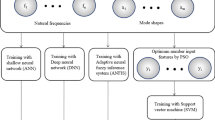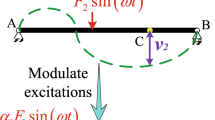Abstract
Structures naturally degrade over time, with the degree of deterioration influenced by factors such as location and construction quality. Additionally, unexpected loads can exacerbate this process, leading to varying degrees of failure. This study aims to improve the early detection of structural damage by integrating vibration-based methods with machine learning techniques, offering greater resilience compared to current approaches. Frequency-based analysis has its limitations, particularly in detecting damage farther from boundaries. To address this gap the study examines twenty-one cantilever beams with differing damage intensities and locations, alongside an undamaged beam, employing both experimental and numerical analyses. Frequency analysis conducted has shown that damage severity and location will affect the natural frequencies, especially revealing that while damage typically decreases fundamental frequency when it is nearer to the boundary and slowly frequency increases, while the damage moves farther from the boundary and for all the scenarios there exists one location where damage frequency is almost equal to undamaged. So, frequency analysis alone may sometimes fail to accurately detect damage. To overcome this limitation support vector machine algorithms are employed for the data obtained from the experimental analysis and found to achieve an accuracy of 85% in predicting the presence of damage, irrespective of its severity.
























Similar content being viewed by others
Availability of data and material
Not applicable.
Code availability
Not applicable.
Abbreviations
- VBM:
-
Vibration-based method
- SHM:
-
Structural health monitoring
- NDT:
-
Non-destructive test
- FFT:
-
Fast Fourier transform
- EMA:
-
Experimental modal analysis
- FEM:
-
Finite element method
- FRF:
-
Frequency response function
- MAC:
-
Modal assurance criteria
- RFS:
-
Relative frequency shifts
- IIRS:
-
Iterated improved reduction system
- TMT:
-
Theoretical modal testing
- PCA:
-
Principal component analysis
- SVM:
-
Support vector machine
- ANN:
-
Artificial neural network
- ML:
-
Machine learning
- M1:
-
Model-1 with damage intensity of 1 mm
- M2:
-
Model-2 with damage intensity of 2 mm
- M3:
-
Model-1 with damage intensity of 3 mm
- UD:
-
Undamaged
References
Raeisi F, Mufti A, Mustapha G, Thomson D (2017) Crack detection in steel girders of bridges using a broken wire electronic binary sensor. J Civil Struct Health Monit 7:1. https://doi.org/10.1007/s13349-017-0211-1
Li Y, Ding Y, Zhao H-W, Sun Z (2022) Data-driven structural condition assessment for high-speed railway bridges using multi-band FIR filtering and clustering. Structures 41:1546–1558. https://doi.org/10.1016/j.istruc.2022.05.071
Taher S, Li J, Jeong J, Laflamme S, Jo H, Bennett C, Collins W, Downey A (2022) Structural health monitoring of fatigue cracks for steel bridges with wireless large-area strain sensors. Sensors 22:5076. https://doi.org/10.3390/s22145076
Katam R, Kalapatapu P, Pasupuleti VDK (2022) A review on technological advancements in the field of data-driven structural health monitoring. In: European workshop on structural health monitoring. Springer, Cham, pp 371–380. https://doi.org/10.1007/978-3-031-07322-9_38.
Katam R, Pasupuleti VDK, Kalapatapu P (2023) A review on structural health monitoring: past to present. Innov Infrastruct Solut. https://doi.org/10.1007/s41062-023-01217-3
Zhang C, Wan Le, Wan R-Q, Yu J, Li R (2022) Automated fatigue crack detection in steel box girder of bridges based on ensemble deep neural network. Measurement 202:111805. https://doi.org/10.1016/j.measurement.2022.111805
Tong T, Lin J, Jiadong H, Gao F, Zhang H (2021) Crack identification for bridge condition monitoring using deep convolutional networks trained with a feedback-update strategy. Maintenan Reliabil Condit Monit 1:37–51. https://doi.org/10.21595/mrcm.2021.22032
Quqa S, Martakis P, Movsessian A, Pai SG, Reuland Y, Chatzi E (2022) Two-step approach for fatigue crack detection in steel bridges using convolutional neural networks. J Civ Struct Heal Monit. https://doi.org/10.1007/s13349-021-00537-1
Das S, Saha P, Patro S (2016) Vibration-based damage detection techniques used for health monitoring of structures: a review. J Civ Struct Health Monit 6:1. https://doi.org/10.1007/s13349-016-0168-5
Cao M, Sha G, Gao Y, Ostachowicz W (2017) Structural Damage Identification Using Damping: A Compendium of Uses and Features. Smart Mater Struct 26:1. https://doi.org/10.1088/1361-665X/aa550a
Kong X, Cai CS, Hu J (2017) The state-of-the-art on framework of vibration-based structural damage identification for decision making. Appl Sci 7(5):497. https://doi.org/10.3390/app7050497
Al-Janabi I, Weli SS, Hamid F (2021) Cement-based materials for self-sensing and structural damage advance warning alert by electrical resistivity. Mater Today: Proc 46:615–620. https://doi.org/10.1016/j.matpr.2020.11.381
Hou R, Xia Y (2020) Review on the new development of vibration-based damage identification for civil engineering structures: 2010–2019. J Sound Vib 491:1. https://doi.org/10.1016/j.jsv.2020.115741
Zhao J, Zhang L (2012) Structural damage identification based on the modal data change. Int J Eng Manuf 2:59–66. https://doi.org/10.5815/ijem.2012.04.08
Yan YJ, Wu Z, Yam LH (2007) Development in vibration-based structural damage detection technique. Mech Syst Signal Process 21:2198–2211. https://doi.org/10.1016/j.ymssp.2006.10.002
Tawade S, Patil R, Kale S, Professor A (2022) Comparative analysis of natural frequency of transverse vibration of a cantilever beam by analytical and experimental methods
Ishan N, Ritvik B, Stephen N, Chippa SP (2021) Experimental modal parameter identification and validation of cantilever beam. Mater Today: Proc 38(1):1. https://doi.org/10.1016/j.matpr.2020.07.396
Gillich G-R, Maia N, Abdel WM, Tufisi C, Korka Z, Gillich N, Pop M (2021) Damage detection on a beam with multiple cracks: a simplified method based on relative frequency shifts. Sensors 21:5215. https://doi.org/10.3390/s21155215
Chaudhari C, Gaikwad J, Bhanuse V, Kulkarni J (2014) Experimental investigation of crack detection in cantilever beam using vibration analysis. In: ICNSC 2014 - Proceedings 1st International Conference on Networks and Soft Computin, pp 130–134. https://doi.org/10.1109/CNSC.2014.6906685
Das S, Dhang N (2021) Damage identification of structures using incomplete mode shape and improved TLBO-PSO with self-controlled multi-stage strategy. Structures 35:1. https://doi.org/10.1016/j.istruc.2021.07.089
Siva SBC, Srinivasa RP, Bala KA (2021) Modal testing and evaluation of cracks on cantilever beam using mode shape curvatures and natural frequencies. Structures 32:1. https://doi.org/10.1016/j.istruc.2021.03.049
Maes K, Meerbeeck L, Reynders E, Lombaert G (2022) Validation of vibration-based structural health monitoring on retrofitted railway bridge KW51. Mech Syst Signal Process 165:108380. https://doi.org/10.1016/j.ymssp.2021.108380
Khalkar V, Kumbhar S, Logesh K, Hariharasakhtisudhan P, Jadhav S, Danawade B, Gharat S, Jugulkar L, Borade J (2022) Experimental and numerical investigation of a cracked cantilever beam for damping factor to access its applicability in the crack detection. U Porto J Eng 8:1. https://doi.org/10.24840/2183-6493_008.002_0013.
Kamariotis A, Chatzi E, Straub D (2023) A framework for quantifying the value of vibration-based structural health monitoring. Mech Syst Signal Process 184:109708. https://doi.org/10.1016/j.ymssp.2022.109708
Rao M, Ch A (2022) A Novel Feature-Based SHM Assessment and Predication Approach for Robust Evaluation of Damage Data Diagnosis Systems. Wireless Pers Commun 124:1–25. https://doi.org/10.1007/s11277-022-09518-z
Ghiasi R, Torkzadeh P, Noori M (2016) A machine-learning approach for structural damage detection using least square support vector machine based on a new combinational kernel function. Struct Health Monit 15:302–316. https://doi.org/10.1177/1475921716639587
Yam LH, Yan YJ, Jiang J (2003) Vibration-based damage detection for composite structures using wavelet transform and neural network identification. Compos Struct 60:403–412. https://doi.org/10.1016/S0263-8223(03)00023-0
Yan YJ, Yam LH (2004) Detection of delamination damage in composite plates using energy spectrum of structural dynamic responses decomposed by wavelet analysis. Comput Struct 82:347–358. https://doi.org/10.1016/j.compstruc.2003.11.002
Liu Q, Zhang J, Liu J, Yang Z (2022) Feature extraction and classification algorithm, which one is more essential? An experimental study on a specific task of vibration signal diagnosis. Int J Mach Learn Cybern 13:1–12. https://doi.org/10.1007/s13042-021-01477-4
Pranesh H, Suresh K, Manian S, Jegadeeshwaran R, Gnanasekaran S, Manghi TM (2021) Vibration-based brake health prediction using statistical features—a machine learning framework. Mater Today Proc 46. https://doi.org/10.1016/j.matpr.2021.02.060.
Katam R, Kalapatapu P, & Pasupuleti VDK. (2023). Smart Diagnosis of a Cantilever beam using SVM. International Conference on Emerging Techniques in Computational Intelligence. pp. 27–32. https://doi.org/10.1109/ICETCI58599.2023.10331129.
Funding
Not applicable.
Author information
Authors and Affiliations
Contributions
Rakesh Katam: Acquisition of data, and images, drafting of the manuscript, and providing the revised article content. Venkata Dilip Kumar Pasupuleti: Provided the area of study, Acquisition of data, and images, drafting of the manuscript, provided the revised article content, and final approval of the version to be submitted. Prafulla Kalapatapu: The manuscript provided the revised article content and final approval of the version to be submitted.
Corresponding author
Ethics declarations
Conflict of interest
All authors have no conflict of interest toward this review article.
Ethical approval
This article does not contain any studies with human participants or animals performed by any of the authors.
Informed consent
Formal consent is not required for this type of study.
Consent for publication
We, the undersigned, consent to the publication of identifiable details, which may include a photograph(s) and details within the text to be published in the IIS “Innovative Infrastructure Solutions” Journal.
Rights and permissions
Springer Nature or its licensor (e.g. a society or other partner) holds exclusive rights to this article under a publishing agreement with the author(s) or other rightsholder(s); author self-archiving of the accepted manuscript version of this article is solely governed by the terms of such publishing agreement and applicable law.
About this article
Cite this article
Katam, R., Pasupuleti, V.D.K. & Kalapatapu, P. SVM-assisted damage identification in cantilever steel beam using vibration-based method. Innov. Infrastruct. Solut. 9, 149 (2024). https://doi.org/10.1007/s41062-024-01459-9
Received:
Accepted:
Published:
DOI: https://doi.org/10.1007/s41062-024-01459-9




